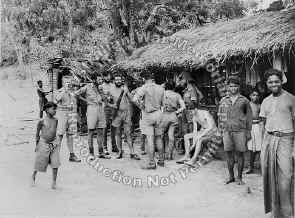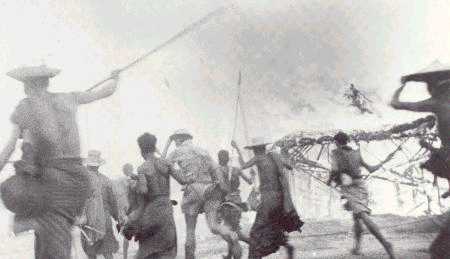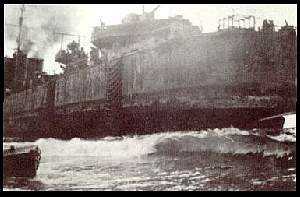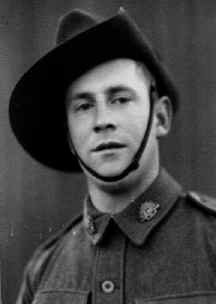 |
|
|||
|
|
||||
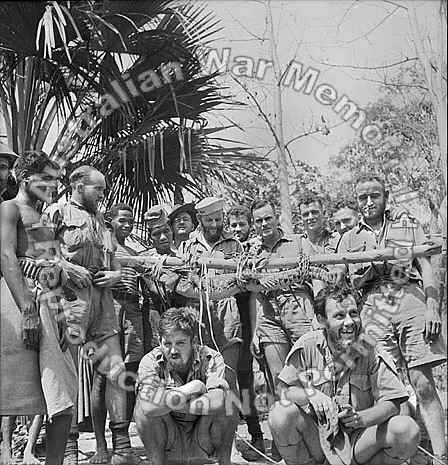 |
1942-12-09.
TIMOR
- AUSTRALIAN
GUERILLAS IN TIMOR. AS A FRIENDLY GESTURE, NATIVES BROUGHT IN THIS LIVE
CROCODILE 12 MILES TO AN AUSTRALIAN OFFICER.
(NEGATIVE BY PARER).
|
I joined the A.I.F. in May 1941, we trained at Brighton camp until August, then thirty of my mates went by ship to Melbourne. We then went by train to a camp at Darele Victoria. We did more training for a few more weeks and then left by train for Adelaide. We were then told we would be reinforcements for the 2/40 Tassie Battalion. We then left by train for the far north of South Australia. From there we went by train and truck for ten days to the Northern Territory. Us Tassie's soon got very sun burnt. It was a very hard, hot and dusty trip. At last we arrived at Noonamah, 40 miles south of Darwin. I soon met several mates who I had bike raced with. My sergeant was Lloyd Spencer from Launceston, Still a very good friend. After about a month we had leave to go to Darwin. It was an eye opener. There would be several hundred troops on leave, army troops, also Navy and Air force. There were three pubs, The Don, Victoria and Darwin. About the only women were black as most white women were sent down south. In late October I was told I would be going down to Adelaide River with D Company. Adelaide River is about 70 miles south of Darwin. Our company was on guard duties as most of the bombs, ammunition, etc were there. It was two hours on and four hours off, very hot 35 to 40 degrees. Loading petrol drums in the heat was the worst. We had a swimming pool there as most of the crocks were up in the salt-water part of the Adelaide River. The Catholic Padre used to go up and shoot them. We called him Crocodile Bill. We also had games at night, two up, crown and anchor etc. I went back with the company to Noonamah late November. We thought then we were going to have six weeks leave down south; but on the night of December the 7th we were told to pack all our gear as we were going overseas. Most of us, including myself were a bit down as I thought I would bet home to see my mother and three sisters. The Battalion left by truck for Darwin on the 7th of December 1941. We all had to wait on the Darwin wharf for many hours to go onto the S. S. Zealandia. It was a very hot and dry wait. When we got on board the ship they let us know that Japanese aircraft had bombed Pearl Harbor and we were at war with Japan. Also told we were going to Timor about 450 miles from Darwin. When the ship arrived we waded ashore with the help of Timorese natives. We were soon on guard duty again. First on ammo guard above the Penfoi Airstrip. Next we went to the other side of the airstrip and built weapon pits. Also strung a lot of barbed wire, bastard of stuff. My mates and I went into Koepang on leave. I drank a lot of French brandy, couldn't get any beer there being Dutch. When I get back I fell on the coral, being drunk from the brandy, scraped my legs which soon started tropical ulcers. Early in the New Year 1942 I was helping to load mortar bombs when five fighter planes flew over. We thought they were yank planes but soon found out they were Japs as they shot us up with machine-gun and cannon fire. Mostly their fire was directed at the hangers and any aircraft that were there. From then on there were a lot more raids and aircraft were shot up on the drome. In late January we received the last of our reinforcements. These were very young and had not had much training. Some were only 16 years of age. By now I knew the invasion would come any time. On the night of the 19 February we moved out of our position. I was on a 1917 Lewis Machine gun (they had good equipment) .We carried the gun, tripod, magazines, etc. When we arrived at Baboe we found the Japs had landed a lot of Paratroops. They had captured some of our men and were very cruel to them. The Japanese had dug in on Osoe Ridge and were between us and the rest of the Battalion at Champolong. On he Sunday evening of February the 22nd. the Colonel decided we had to take the ridge. The mortars and vicars machine guns put up heavy fire. Then the Lewis gunners, including the rifle companies and myself moved up. My mate and I set up the gun and soon the mortars set fire to several native huts that the Japs were in. They came out and we shot several of them. I had to go back for more ammo. When I got there a Jap threw a grenade, the main blast hit some palm trees. I was lucky. But I was hit with some shrapnel on my left arm left leg and back. The blast knocked me over, it knocked me right down the bloody hill. Several others of the company were wounded at the same place. Quite a lot with rifle fire wounds. We got together and soon our mates, some from the band, came and found us. In action the men from the band in those days were medics. We were now walking wounded. Fighting was now about over. We got back to the road and the wounded were put in to a Bren gun carrier. The colonel sent out a patrol to see if the road ahead was clear. They found there was a Japanese roadblock between the battalion and Champolong. It was decided to stay on the road that night as we had about 140 wounded also some men with malaria. Next morning the Japanese who had landed on the coast caught up with us. An officer with a white flag came in front, he was in with what I think was a small tank. We were told 24000 Japanese troops had landed on the coast. The Japs left with the colonel and some of our officers to go back to Kopan and to arrange surrender. We could not fight on as the wounded were at the rear of the convoy and we were nearly out of ammunition and very short of water. Some time later several Japanese heavy bombers came over and started to drop bombs. I was blown out of the bren carrier but not badly hurt. Several of our men were killed and quite a few Japanese, which was bloody good they bombed their own troops. Once the Japanese got their message to the bombers they flew away and the surrender took place. We were taken to Baboo where the Japanese burnt their dead, as our battalion killed about 800 of their crack paratroop regiment. The stink was awful, it was shocking, they had been dead for days, and they piled them up and burnt them. They then took us to Osesapa Besar (it means near the sea in Timorese) and told the fit men they had to build their own prison camp. I and many others, who were wounded or had malaria, or very severe type of dysentery, were just put on the ground as we were useless to the Japanese. I thought we would be shot. I was next to an old mate of mine, Bill Harper, who was shot in the mouth. Soon the flies blew the wound, (he was a cousin of Judy's mum). Also Elton Fitzmaurice was shot in the throat, (HE was a cousin I think, he was in my company). The Japs would not do anything for these men and Fitzmaurice died. Also another mate out of my company was shot in the leg he got gangrene and he died hard. There was very little water and hardly any food. I did what I could for Bill and others came and cleared me up the best they could. I was taken next to a so-called hospital, it was just a native hut with bamboo slats for beds. I was very sick with dysentery and malaria and think I would have died if some of my mates had not came and carried me back to the main prison camp. They fed me and I started to get a little strength back. It was very hard to try and eat rice with weevils and mice droppings in it. About this time many Jap planes used to leave the airstrip at Panfore to bomb Darwin and Broom. It was a great feeling to see some come back with damage from Ack Ack fire. And we knew the R.A.F. were having a go at them. About September 1942 we left Timor on a prison ship for Java. When we arrived at Dili, East Timor, the ship was bombed by the R.A.F. I got a belting from a Jap for not going down into the hold quick enough. The ship took us to Java from where we landed we went by train to a prison camp near Batavia . The camp was Tanjong Priock. There were a lot of English troops there. I was soon getting a lot of dysentery and malaria and getting very weak. I went on a few working parties, Next I was moved with a lot of 2/40th blokes to cycle camp. This had been a Dutch army barracks. The commander was captain Sony. He was a real bastard. If you did not bow to the guards in cycle camp you would get a hiding. I got sick again in this camp and men mates were very good to me. All we could do when we had malaria was to look after each other. Our meal was about three-breakfast cup of rice day. With sometimes a very, weak, watery soup. If on work party you had to work hard on this ration. I was moved from this camp to Makasura. We went out on work parties. The Japs were sending a lot of scrap iron back to Japan so you had to load old engine blocks etc. They tried to split the 2/40 up as most of the men tried to give them a bit of trouble. Others and myself were then sent to Glodock Gaol. This had been a civilian jail and was full of bugs and lice. I slept on a cement floor, we had a couple of rice bags for cover. The guards were pretty hard here. There were several bashings. The next move I had was to a comp in the hills. The job was planting castor oil seeds. You had to dig a hole at a certain depth and pout three seeds in There was not so much malaria here as it was a bit cooler. This was early in 1944. Soon we were told "all men go to Nippon", Japan. They told us it would be better there but I knew better than that. We left Batavia down in the holds of an old rusty ship, there were rats down there. We arrived at Singapore in early May 1944. We stayed a few days in River Valley Camp it was wet and miserable. We got three cups of soggy rice a day. We were then put on another ship and went to Manila. There was some sub scares on the way. From Manila we went to Formosa, which is now Taiwan. Here we changed ships. Dave Lewis, Cyril and myself Eagling made up our minds we would not go into the holds, we got a few bashings but stayed up on the decks. I've told the story of the sinking of the ship, It was in the examiner. When we arrived at Nagasaki the Japs kept us out in the cold and heavy rain after we had been 14 hours in the water. At last we were made to get into some trucks I had a hard job getting in, as my right leg was hurt getting off the ship. The Japs took us to a camp in Nagasaki and gave us clothes and a feed of hot rice, also weak green tea to drink. After a few days we were told we would have to go to work in a Mitsubishi foundry. About 14 others and I were picked to work on an electric furnace. It was very hard work and the guards were very hard. I was getting very weak and several of my mates died as we had to walk through the deep snow to the furnace, and they got pneumonia. You would be very hot during the work then you would walk through the cold to the camp. My mate Dave Lewis got pneumonia the Japs would not give any drugs and his lungs burst out through his ribs. When I would try to take him to the toilet and I could not bow I would get a bashing. The Japs then decided to take the weaker ones to work in a coal mine called, Omanie. I went from Nagasaki by train and when we got there I met a lot of my mates who had worked on the Thailand railway. First I worked in the mine then got a job working on a tunnel. I think when and if the American marines landed we would have been put in the tunnel and they would have blown us up. Big bombing raids started then some times we would spend hours in air raid shelters. By July 1945 we knew that the war was getting close we heard that the Island of Okinawa had been taken. On the 15 August we did not have to go to work in the tunnel. The next day I did not bow to a Jap and he did not slap me. I was just about sure that the war was over. After a few days a message was dropped from a United States fighter plane, it told us the was with Japan was over. After over three and a half years it was hard to believe. It took some time for the B29's to find us. But when they did it was like pennies from heaven. They dropped by parachute 44-gallon drums with everything in them. Clothes, boots, socks, and best of all food and American smokes. I was just over 6 stone then. After a few weeks we all started to put on weight. Next the United States marines came in, it was a great sight to see. I knew then that the war was over. They told us as soon as the lines were prepared we would be going down to Nagasaki by train. Before we went we went into Omanai and got some Jap beer. It did not take long to get a kick after nearly four years. When I got to Nagasaki I could hardly believe what I could see. About 90 percent of the city was wiped out. The trams were still on the rails, all burnt out where the atomic flash had cooked them. Our old camp and factory had been wiped out. We were taken to the wharf area and sprayed to get rid of any lice, bugs and radiation etc. I asked a marine what will I do with my old clothes and he said see that Jap there, throw them as hard as you can at him and let him have some bugs and lice. We were them given new united states clothes and the next morning, Sunday, I went to church parade on the united states ship Wichita. That afternoon, about 50 others and myself went aboard the United States destroyer green .We had pictures on the deck that night and plenty of ice cream. Next day we arrived at Okinawa. There were hundreds of ships there. When we got near the island we could still smell the dead Japs who the marines had burnt in their tunnels with their flame-throwers. We then went on to the Royal Navy Aircraft carrier, "The Speaker". The English sailors treated us very well. We had a bout 3 days on the speaker and then arrived at Hong Kong. I had leave there and met a lot of sailors off the Aussie destroyers. We soon found some beer and had a great day. Next we went to Manila. It was a bit of a mess. The United States battle ships had shelled the city with 16 inch guns. I had a stay in Manila about ten days as I proved positive with hookworm. An American Negro treated me, he was real kind to me. He brought myself and my mates cigars, cigarettes and when we got over the treatment Indian head beer and ice cream, he was a ripper that bloke. About 25 who had hook worm including myself missed the Speaker. We were told we would fly home. We flew out of Manila an RAF Catalina Flying boat. It was great to fly over the islands and to think all the fighting was over. We had one night at Moratoria. Plenty of Aussie troops and nurses there. Next day we arrived in Darwin. It was great to see Australasia again. We stayed in Darwin about ten days. I had put on quite a bit of weight, The army girls were good to us and they sewed on out colour patches. It was great to sleep in a bed with sheets. They got me a call through to Launceston and I spoke to my sister Gwen. She told me that, Margaret and Bessy were married. I saw the damage done to Darwin and where the Japs had shot up the hospital. You could never like these people. I was told I would be flying to Melbourne in a big RAF bomber. I thought I may have seen Fred as Gwen told me He was flying Liberators. We landed in Melbourne after an eight-hour flight non-stop. We were taken to the Repat Hospital that night a mate and myself got leave to go into the city. We met a couple of army girls and went to the hotel Australasia. Then it was the best hotel in Melbourne. We had a good night. They day after we were taken to the wharves and went onto the steamer Nairana which went from Melbourne direct to Launceston. It was wonderful coming up the Tamar and to see all the apple blossom out, and to smell the gum leaves. When we got to Launceston there was a big crowd to meet us my mum three sisters and my new brother- in-laws, Fred Bob, and Monty. I then went to out home in Mulgrave Street where there was a big banner with "Welcome Home John on it. That night we had a big family and friends get together and I knew at last for me the war was over. |
